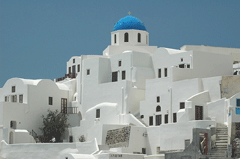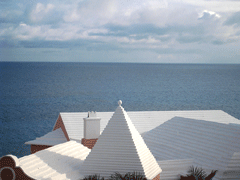Painting the Town White
Air Date: Week of February 13, 2009

In Santorini, Greece houses are painted white to keep them cooler. (Photo: Jaap Engel)
Painting the roof of a house white reflects solar radiation back to the atmosphere and helps cool the planet. California Energy Commissioner Arthur Rosenfeld tells host Bruce Gellerman that a white roof not only saves on air conditioning costs but, also, offsets the heating effects of ten tons of carbon dioxide emissions.
Transcript
GELLERMAN: When it comes to taking on the challenge of climate change, California leads the way – with the nation’s most comprehensive plan to control greenhouse gas emissions.
Now Arthur Rosenfeld, the state’s energy commissioner has come up with another bright idea to cool the planet. He wants to paint the town white – or at least, the roofs and roads. Arthur Rosenfeld joins me from his office in Sacramento.
Hello Commissioner!
ROSENFELD: Hello, Bruce.
GELLERMAN: So, white roofs and roads can help cool the planet, how?
ROSENFELD: Well, everybody who’s ever walked on a roof knows if it’s white it will only heat up maybe ten degrees above ambient temperature. If it’s some nice architectural green or terracotta tiles or whatever, it can heat up to eighty degrees above room temperature. So a white roof reflects solar radiation back into space where it’s transparent, where it belongs, and a dark roof traps heat and contributes to the greenhouse effect.
GELLERMAN: We should say this is not a new idea. The ancient Greeks knew about building in light colors long, long ago.
ROSENFELD: The Greeks have known to white wash their roofs and their whole buildings for 2,000 years, and the Pharaohs had white roofs 5,000 years ago.

In Santorini, Greece houses are painted white to keep them cooler. (Photo: Jaap Engel)
GELLERMAN: Well, calculate the effects. I just put a new roof on my house actually. I live just outside of Boston. And how much money would I save if I put up a white roof. I gotta tell, you I put up a dark roof.
ROSENFELD: Instead of giving it to you in dollars, because I don’t know your air conditioning load and your habits, I can say that it will reduce your air conditioning by 10 to 20 percent, or your air conditioning load on the summer by 10 to 20 percent if the roof is white instead of whatever you put up. White roofs are good because they save air conditioning and they’re common sense. But in addition the white roof, because it doesn’t trap energy, reflects it back into space, cools the world directly. And for 1,000 square feet which is like half the area of your house, a white roof as opposed to a dark roof cools the world enough to offset the heating effects of ten tons of carbon dioxide. That’s like two and a half years of emissions from your family car or like one year’s emissions from your house near Boston. And that’s why we’re so excited right now.
GELLERMAN: What about in winter? I mean doesn’t a dark roof absorb heat as you said and that would lower the winter energy costs?
ROSENFELD: Right. That is a problem, which we call the winter penalty. In Boston it runs nearly 15 percent, that is if you save a dollar on air conditioning in the summer, you pay back fifteen cents worth of natural gas for the heating in the winter. But if you’re in Birmingham, Alabama the winter penalty is only about five percent. And the reason for that is that in the summer, the sun is high and sees mainly the roof. In the winter, the sun is low and sees mainly the south wall. So a really architecturally-colored proper building will have a light colored roof for the summer time and a dark colored south wall to absorb heat in the winter.

These white roofs in Bermuda reflect solar heat back to the atmosphere instead of absorbing it as dark roofs would. (Photo: Lornette Simons)
GELLERMAN: I know that California has a requirement for flat roofs. It’s had it since 2005. They have to be white. And now you’re going even further.
ROSENFELD: Yes, we’re going further in two directions. What we’ll require in California on a new building is that if it’s flat and there’s no architectural issues, then it’s gotta be white, and a re-roofing job has got to be white. We have invented cool colors, which is pigments, which are naturally occurring but selected to be any color you want in the visible, but highly reflective – that is kind of white – in the near infrared. And so in California, starting next August, if it’s a sloped roof in our hottest climate zones, it must be one of these cool-colored pigments. Another interesting idea is that California State Fleet will start to purchase only cars which are white or metallic gold or metallic silver – those are, those run about 18 degrees cooler when parked – the skin of the car when parked on the parking lot. You can down size the air conditioner. So, that’s the way we’re going in California.
GELLERMAN: I understand you’re taking your idea for white roofs on the road. You’re headed for China and India.
ROSENFELD: Right. The Chinese have mandatory building standards and I want to convince them to make white roofs a high priority. If you landed an airplane in Shanghai or Beijing you find lots of flat roofs which are red or blue, but not white as they should be. The Indians have voluntary standards, and I want to try to convince them to make their first mandatory standard which costs nothing and is easy to enforce to be a white roof. If white roofs took over the world or the urban world over a twenty year program, we would save twenty five billion tons of CO2, which is the same as turning off the whole world’s emissions of CO2 for one year. It’s a wonderful way to delay global warming and at the same time cool your communities and save air conditioning energy and save a little bit of extra CO2 from the electricity at the power plant.
GELLERMAN: Well Commissioner Rosenfeld, thank you very much.
ROSENFELD: It was a pleasure. Hope we talk again.
GELLERMAN: White roof advocate Arthur Rosenfeld is the Energy Commissioner for the Golden State of California.
Links
Living on Earth wants to hear from you!
Living on Earth
62 Calef Highway, Suite 212
Lee, NH 03861
Telephone: 617-287-4121
E-mail: comments@loe.org
Newsletter [Click here]
Donate to Living on Earth!
Living on Earth is an independent media program and relies entirely on contributions from listeners and institutions supporting public service. Please donate now to preserve an independent environmental voice.
NewsletterLiving on Earth offers a weekly delivery of the show's rundown to your mailbox. Sign up for our newsletter today!
 Sailors For The Sea: Be the change you want to sea.
Sailors For The Sea: Be the change you want to sea.
 The Grantham Foundation for the Protection of the Environment: Committed to protecting and improving the health of the global environment.
The Grantham Foundation for the Protection of the Environment: Committed to protecting and improving the health of the global environment.
 Contribute to Living on Earth and receive, as our gift to you, an archival print of one of Mark Seth Lender's extraordinary wildlife photographs. Follow the link to see Mark's current collection of photographs.
Contribute to Living on Earth and receive, as our gift to you, an archival print of one of Mark Seth Lender's extraordinary wildlife photographs. Follow the link to see Mark's current collection of photographs.
 Buy a signed copy of Mark Seth Lender's book Smeagull the Seagull & support Living on Earth
Buy a signed copy of Mark Seth Lender's book Smeagull the Seagull & support Living on Earth

